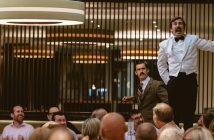From entertainment mogul to photographer, the Donn Delson has carved a unique path in the art world. Ollie Pickup flies with the man who’s spent over 100 hours in doorless helicopters, capturing breathtaking images that challenge our view of urban landscapes and natural wonders…
It’s 10:33am on a Tuesday in May, and possibly the best email I’ve seen this year pops into my inbox.
The subject line? “Invitation to Fly in a Helicopter with Aerial Photographer Donn Delson”.
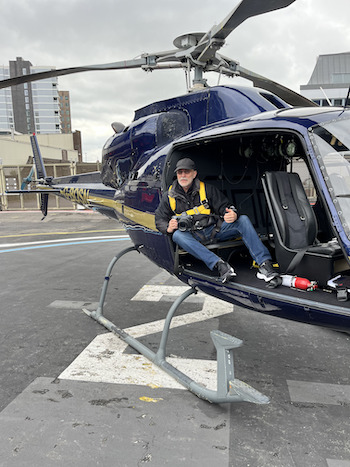 The opening paragraph? “I would like to invite you to experience the heights of aerial photography, literally, by joining 75-year-old American fine art photographer Donn Delson on a helicopter ride above London.” Unable to keep my cool, I call the PR immediately to express my interest.
The opening paragraph? “I would like to invite you to experience the heights of aerial photography, literally, by joining 75-year-old American fine art photographer Donn Delson on a helicopter ride above London.” Unable to keep my cool, I call the PR immediately to express my interest.
A week later, I’m pinching myself as I step into a six-person helicopter with Donn at the London Heliport in Battersea — a stunning Succession-like setting next to the Thames (apparently, Tom Cruise flew out later that day). I feel like Charlie with the golden ticket after the PR informs me that “hundreds of journalists” had unsuccessfully applied for a chopper ride with the artist over the capital.
I do my best to quell any nerves – the helicopter crash that killed President of Iran Ebrahim Raisi four days earlier isn’t helping – but Donn, his trusty Fuji GFX 100 in hand, ushers me aboard with a reassuring grin. He is in the back-right seat, the door flung open so he can snap away. With the rotor blades making conversation inaudible, I tug the safety belt tight, and snap on the headset above me.
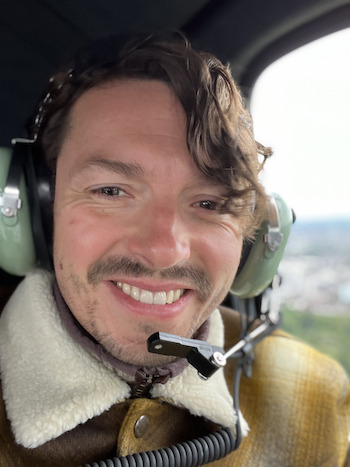 Soon, the pilot, Tim, lifts us up and away from the heliport. The next 20 minutes are exhilarating and magical — despite the helicopter door gaping open — as we snake above London, feeling like VIPs. Using his microphone and his fingers, Donn points out landmarks. And he’s particularly interested in the British Museum. The photographer asks Tim to hover, as the aircraft is tilted, so he can take his shot.
Soon, the pilot, Tim, lifts us up and away from the heliport. The next 20 minutes are exhilarating and magical — despite the helicopter door gaping open — as we snake above London, feeling like VIPs. Using his microphone and his fingers, Donn points out landmarks. And he’s particularly interested in the British Museum. The photographer asks Tim to hover, as the aircraft is tilted, so he can take his shot.
We have to stay below 2,000 feet (around 600 metres) — I assume for air traffic control reasons — and can’t fly over Buckingham Palace or the Houses of Parliament, understandably. At that height — much lower than Donn is used to flying — the cityscape takes the form of a Lego creation, an assortment of styles and patterns. It’s breathtaking and a sensational way to see the city in which one lives. Humbling, really.
Back on terra firma, still riding high from the flight, I’m keen to quiz this enthusiastic, cultured, curious septuagenarian — who looks, and certainly acts, at least 20 years younger – about this extraordinary life he leads…
Donn, thank you for today. You’ve had quite the career trajectory. Could you tell us about your journey from entertainment merchandising to aerial photography?
Indeed, my path has been rather unconventional. For a significant portion of my life, I’ve been an entrepreneur, with many of my experiences centred around being a founder or CEO. My last major venture before transitioning to photography was building – and selling – the fourth largest entertainment merchandise business globally, BandMerch, to AEG Live in Los Angeles.
I was responsible for worldwide merchandising for an impressive roster of artists, names like Rihanna, Billy Joel, Cheryl Crow. It was an exhilarating time, but as with all things, there came a point where I felt ready for a new challenge.
I’ve always had a passion for photography, dating back to my childhood, when I had a Kodak Brownie camera. However, during those years of intense business growth, I didn’t have the artistic freedom to pursue it beyond capturing family moments and holiday snapshots.
It wasn’t until I sold my last company in 2007 that I could start contemplating a different path. I officially retired in 2010, and that’s when I began to pursue photography more seriously.
That’s quite a transition. Was there a particular moment that sparked your interest in aerial photography specifically?
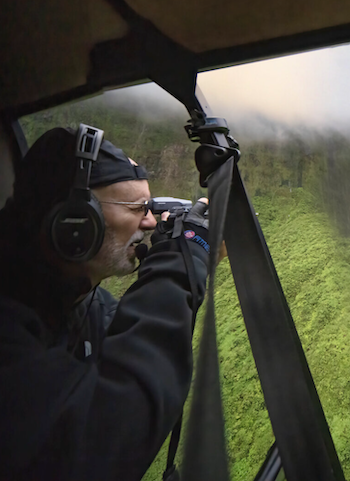 There was. It was a serendipitous moment during a trip to one of my favourite places in the world — Queenstown, New Zealand. My wife and I were on a helicopter flight to see a glacier in the Remarkables mountain range. I had my camera and tripod with me, intending to photograph the waterfalls and the glacier.
There was. It was a serendipitous moment during a trip to one of my favourite places in the world — Queenstown, New Zealand. My wife and I were on a helicopter flight to see a glacier in the Remarkables mountain range. I had my camera and tripod with me, intending to photograph the waterfalls and the glacier.
On our return journey, the pilot, noticing my equipment, asked if I’d like him to open the helicopter’s door. My wife immediately responded, “No”, but I couldn’t resist the opportunity. That moment was truly transformative. The view from the open door was mesmerising and instantly ignited my passion.
This experience resonated deeply with a book I’d read in high school called The Once and Future King, a collection of fantasy novels by T. H. White about the legend of King Arthur. In it, Arthur is transformed into a goose and experiences flight, gaining a new perspective on the world — one without borders, fences, or restrictions. That literary moment had stayed with me, and suddenly, decades later, I found myself living out a similar experience. It felt like a natural progression, a calling I hadn’t realised I’d been waiting for all along.
Your aerial photographs often capture cities from unusual angles, revealing patterns and symmetries that aren’t visible from the ground. How do you approach each shoot, and what are you looking for when you’re up in the air?
My approach is a blend of preparation and spontaneity. Before a shoot, I’ll have a general idea of what I’d like to capture in a particular city. For instance, when coming to London, I had certain iconic landmarks in mind. However, I’ve found that my most successful and exciting pieces are often serendipitous discoveries.
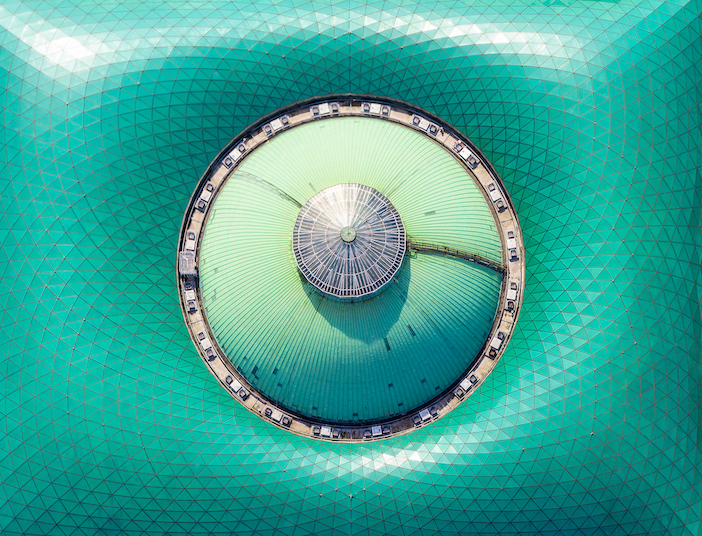
‘Crown Jewel’
The perspective from above is dramatically different from what we see on the ground. I’m obsessed with this concept of perception — the interplay between appearance and reality. Many of my pieces in the Points of View and Flight Patterns collections are whimsical interpretations of what I see from above.
I’m always looking for patterns, symmetry, and unique formations. Cities like London, with their fascinating blend of old and new architecture, offer a treasure trove of visual delights from the air. It’s exciting to discover how structures that weren’t necessarily designed with an aerial view in mind create captivating compositions when seen from above.
You’ve mentioned shooting from a doorless helicopter. Can you tell us more about the technical challenges of aerial photography and how you overcome them?
Shooting from a doorless helicopter presents a unique set of challenges, primarily due to the constant vibration and wind. When you consider that I often enlarge my images to sizes as large as 12 feet by 18 feet, achieving tack-sharp focus becomes crucial and incredibly challenging.
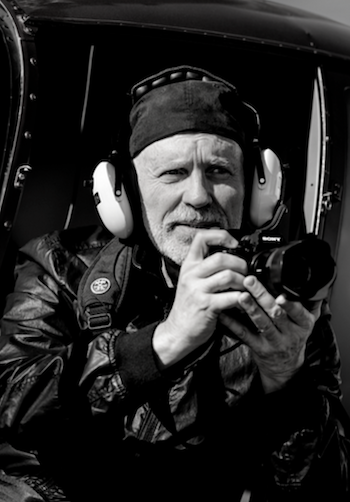 To combat this, I use specialised equipment. My primary camera is a Fuji GFX 100, which gives me an impressive 100 megapixels to work with, allowing for those large-scale prints. I also carry a Nikon D850, which excels in low-light conditions — perfect for twilight shots when city lights are just starting to twinkle.
To combat this, I use specialised equipment. My primary camera is a Fuji GFX 100, which gives me an impressive 100 megapixels to work with, allowing for those large-scale prints. I also carry a Nikon D850, which excels in low-light conditions — perfect for twilight shots when city lights are just starting to twinkle.
I often shoot in burst mode, using the Fuji’s capability to capture five frames per second. This increases my chances of getting at least one perfectly sharp image amidst the helicopter’s vibrations. It’s a far cry from traditional landscape photography, where you can use a tripod and take your time with long exposures.
The lighting conditions also present a challenge, especially during twilight shoots. There’s a delicate balance between having enough light for a clear image and a fast enough shutter speed to counter the helicopter’s movement. It’s a technical dance that requires constant adjustment and a deep understanding of your equipment.
Your work often has intriguing, whimsical titles. Can you share the story behind one of your favourite pieces and its name?
I do enjoy naming my pieces whimsically — it adds another layer of engagement for the viewer. One of my favourites is a piece called Xylophones. This image was captured while flying above the port of Los Angeles. I spotted six rows of containers with two roads running parallel between them. As I was manoeuvring into position to shoot, I noticed a large white lorry starting to move down one of the rows.
I quickly directed the pilot to reposition us, and fortunately, we made it in time for me to capture the truck just before it exited the frame. The resulting image, with its horizontal lines of colourful containers, reminded me of the tonal bars on a xylophone — hence the name.
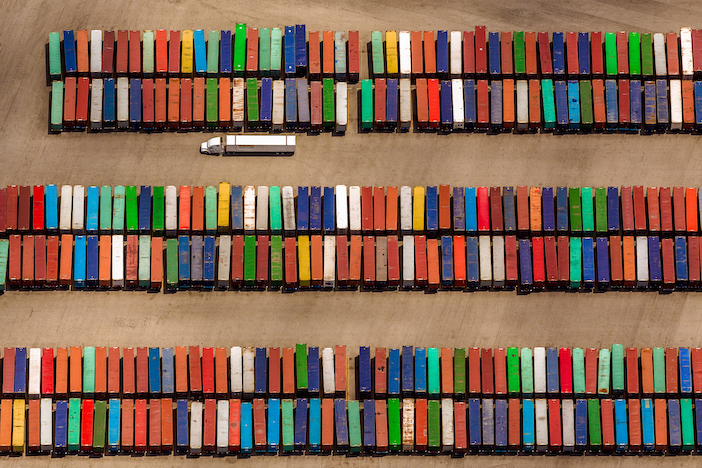
‘Xylophones’
What I find particularly delightful about this piece is its role in perception. Many people who see it at exhibitions initially perceive it as bookshelves. Then, there’s often a moment of confusion when they notice the truck. How could there be a truck on a bookshelf? This leads to a closer inspection and the realisation that they’re looking at containers, not books.
I love these moments of revelation. They serve as a gentle reminder not to make snap judgments and to take a second look before drawing conclusions. It’s a principle that extends beyond art appreciation into everyday life.
You’ve captured some truly breathtaking natural phenomena, including a double circular rainbow. Could you tell us about that experience?
Ah, the double circular rainbow — that was a truly magical moment. We were flying at about 3,000 feet in Hawaii when we encountered a sun shower. Suddenly, there it was: a complete double circular rainbow. It was absolutely breathtaking.
What many people don’t realise is that all rainbows are actually circular. We typically only see half of them from the ground because the horizon cuts off our view. But from the air, with no horizon to obstruct our vision, we could see the entire circle—two perfect, concentric rings of colour suspended in the sky.
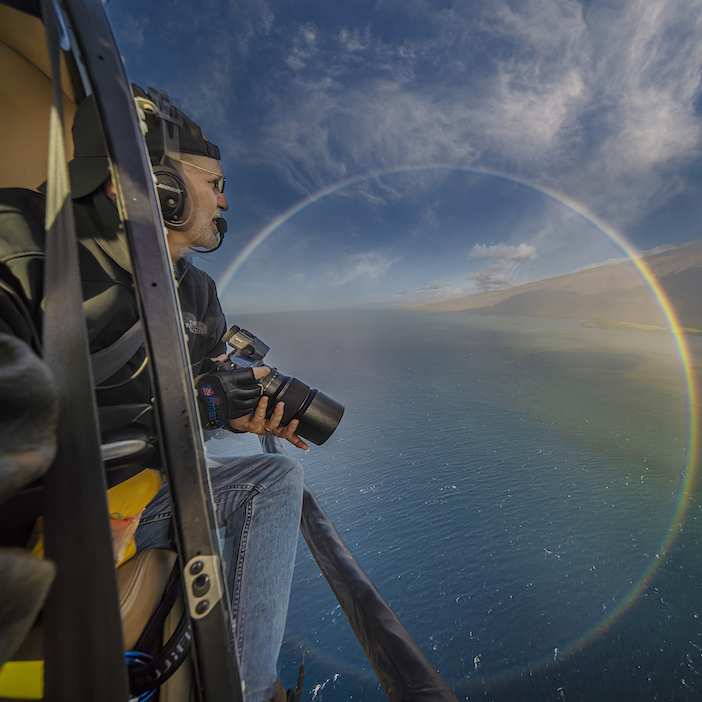
I was fortunate enough to capture this rare phenomenon, and even more fortunate that another photographer in the helicopter managed to take a picture of me shooting into the rainbow. That image and video clip went viral, being viewed millions of times across various platforms.
This experience perfectly encapsulates what I love about aerial photography. It offers the opportunity to witness and capture perspectives and phenomena that are simply not visible from the ground. It reminds us of the incredible beauty and wonder of our world, often hidden just beyond our usual line of sight.
Your work takes you all over the world. Are there any destinations you’re particularly keen to photograph in the future?
I’ve been incredibly fortunate to photograph some amazing locations worldwide—London, Tokyo, Mount Fuji, Kyoto, Israel, Los Angeles, Miami, New York, and more. Each place offers its own unique charm and challenges.
Looking ahead, India is high on my list of desired destinations. The vibrant colours I’ve seen in images of India have always captivated me, and I’m eager to capture that chromatic richness from an aerial perspective. It would be spectacular to fly over India’s diverse landscapes and bustling cities, searching for those brilliant hues and intricate patterns.
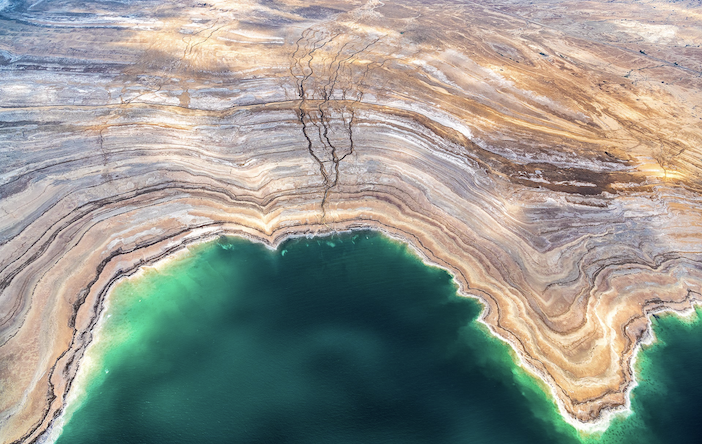
‘Tree of Life’ (Israel)
I’m also always open to revisiting places I’ve photographed before. Cities are constantly evolving, and the same location can offer entirely different visual stories depending on the time of day, season, or even recent developments.
For instance, I still have a shot of London I want to capture—a twilight view from east of Tower Bridge, with the Shard on the left and the Gherkin on the right, as the city lights are coming on. It’s an image I’ve attempted before, but I’m determined to get it just right.
Your aerial photographs often reveal hidden patterns and symmetries in urban landscapes. How can this unique perspective influence our understanding of cities and urban planning?
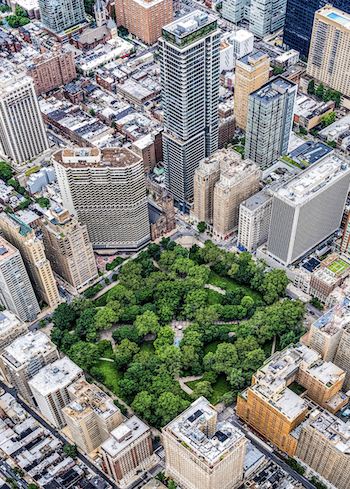
‘On the Square’ (Philadelphia)
Aerial photography offers a unique vantage point that can profoundly shift our perception of urban environments. From above, we can see the intricate tapestry of a city — its layout, its growth patterns, the interaction between built environments and natural landscapes. This bird’s-eye view reveals the city as a living, breathing organism, showing us connections and patterns that are invisible from the ground.
This perspective can be incredibly valuable for urban planners and architects. It allows them to see how different elements of the city interact on a macro scale. They can observe traffic flows, identify green spaces, understand the distribution of residential and commercial areas, and see how the city has grown and changed over time.
Moreover, aerial views can highlight issues not apparent from the street level. They might reveal disparities in green space distribution across different neighbourhoods, for example, or show how industrial areas impact surrounding communities. This information can inform more equitable and sustainable urban planning decisions.
In my work, I often focus on finding beauty and art in these urban patterns. By presenting cities in this way, I hope to encourage viewers to look at their environments differently, to find wonder in the everyday, and perhaps to think more critically about how our urban spaces are designed and used.
Finally, Donn, what do you hope viewers take away from your work?
At its core, I hope my work inspires a sense of wonder and curiosity about the world around us. I want viewers to experience that moment of surprise and delight when they realise what they’re looking at, or when they discover a pattern or symmetry they hadn’t noticed before.
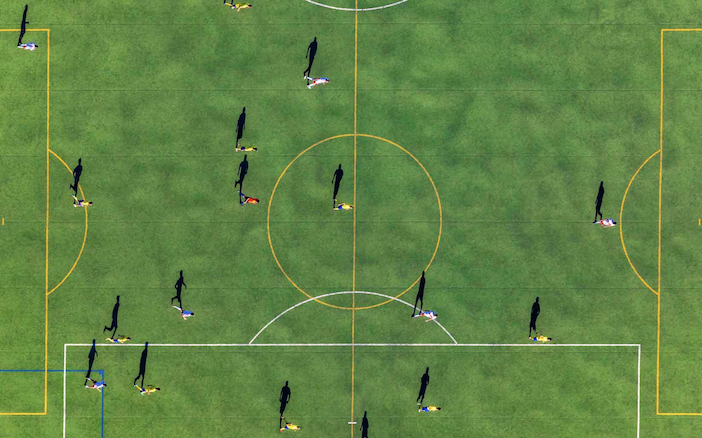
‘Shadow Ball’ (detail)
I also hope my photographs encourage people to question their perceptions and look at things from different angles—both literally and figuratively. The world can look very different depending on your perspective, and I think there’s great value in reminding ourselves of that fact.
Moreover, I want my work to foster an appreciation for the incredible diversity and beauty of our world, both natural and man-made. Whether it’s a landscape’s stunning geological formations or an urban centre’s intricate patterns, there’s so much to marvel at when we take the time to really look.
Art has the power to change perspectives, evoke emotions, and connect us to the world and each other in profound ways. If my work can contribute to that in some small way, I’ll consider it a success.
To see more of Donn’s work, and to purchase prints, please visit www.donndelson.com.


